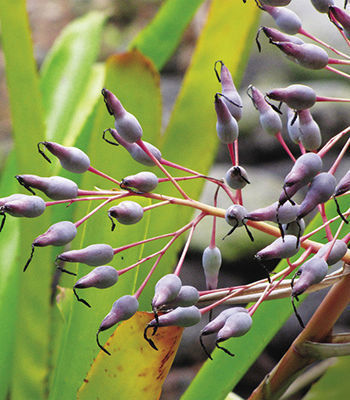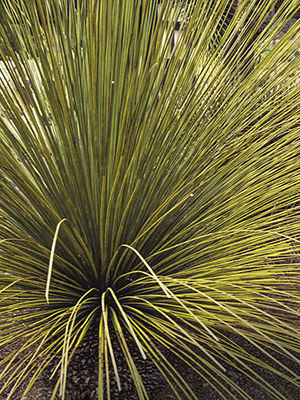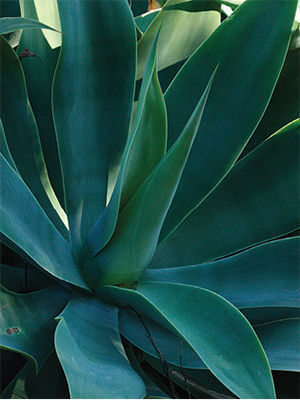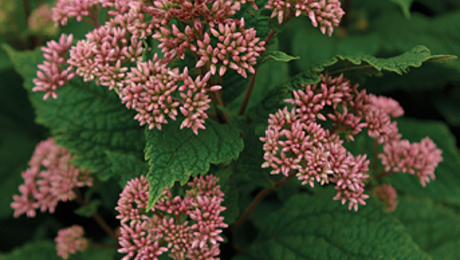1. ‘Orange Aide’ Bromeliad

Name: Aechmea blanchetiana ‘Orange Aide’
USDA hardiness zones: 10 to 11
Size: 3 to 4 feet tall and 2 feet wide
Conditions: Full sun to partial shade; acidic, well-drained soil
Native to Brazil, this bromeliad cultivar develops a beautiful orange tinge on its large leaves when grown in full sun, while in shade, the hue is more of a light green. It is not tolerant of salt spray but is drought resistant once established. The coral red flowers emerge on a stalk in spring from the tight center rosette of leaves and usually last for a few months. The plant can reach 5 to 6 feet tall when in bloom. ‘Orange Aide’ bromeliad has no serious pest problems. I frequently plant it under trees with shallow root systems because it is an epiphyte and has the ability to grow in very shallow soil. Keep it away from the edge of walkways as the spiny margins can hurt passersby.
2. Portea

Name: Portea petropolitana var. extensa
Zones: 9 to 10
Size: 3 to 4 feet tall and 2 feet wide
Conditions: Full sun to partial shade; well-drained soil
This beauty has shiny chartreuse evergreen foliage, with sharp spines along its edges. If portea is grown in the shade, its leaves become dark green. It may reach 3 feet tall prior to flowering, growing in an upright rosette. When in bloom, however, the flower stalk can reach 4 feet tall, so give it the proper room. The 12- to 18-inch-long pink and purple inflorescence contains lavender petals, apple green ovaries, and berries that turn dark purple. The flowers show up in late spring and last until midsummer. Portea can be planted under trees because it will not compete for root space. It makes a striking focal point when planted in a group, and the inflorescence can be used as a cut flower for a long-lasting arrangement.
3. Mexican Grass Tree

Name: Dasylirion longissimum
Zones: 8 to 11
Size: 4 to 6 feet tall and wide
Conditions: Full sun; well-drained soil
This striking evergreen shrub has grasslike, glaucous green leaves that radiate from a central trunk. It is a slow grower but can reach a total height of 12 feet after many, many years. Although the width of the leaves may not be much, the length of the individual blades are a whopping 4 feet long. Native to northeastern Mexico, this plant requires extremely good drainage. The remarkable form of Mexican grass tree makes it an unforgettable focal point; it is striking when uplit at night. I like to combine this plant with low succulents that do not compete with its shape and eye-catching form.
4. Ghost Agave

Name: Agave attenuata
Zones: 9 to 11
Size: Up to 3 feet tall and 6 feet wide
Conditions: Full sun to partial shade; well-drained soil
This smooth-leaf agave is soft to the touch and to the eyes. With pale green foliage, this plant will combine well with tropicals or with other succulents. Its pliable leaves emerge from a tight central spear to arch gracefully back, which makes ghost agave look like a large open green flower. The individual rosettes may reach 4 feet wide atop a stout, smooth gray stem that rises up and curves. Ghost agave tends to create large colonies as new plants grow readily from the base. Its flowers are a pale greenish yellow and develop into many new small plants. If it’s grown in full sun in hot and dry climates, you’ll need to provide some shade for this plant in summer. It will grow in moist or dry soils but looks best with occasional watering. This agave tolerates seaside conditions.
Amelia Lima is the principal designer and owner of Amelia B Lima & Associates, Inc., a landscape design firm in San Diego, California.
Photos: #1, Joshua McCullough; #2, millettephotomedia.com; #3, Jerry Pavia; #4, Kerry Ann Moore

















Comments
Log in or create an account to post a comment.
Sign up Log in